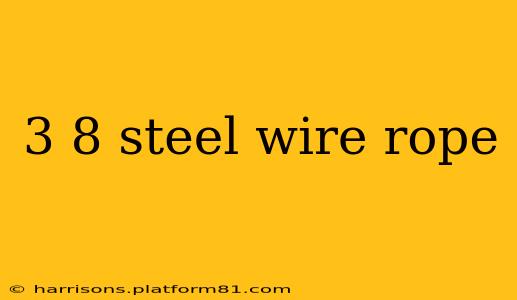Steel wire rope, a crucial component in various industries, offers exceptional strength and durability. This article focuses specifically on 3/8" (or 9.5mm) diameter steel wire rope, exploring its properties, applications, and factors to consider when selecting it for your needs. Understanding its specifications and limitations is key to ensuring safety and optimal performance.
What are the different types of 3/8" steel wire rope?
Several factors influence the type of 3/8" steel wire rope best suited for a particular application. These include the number of strands, the number of wires per strand, and the type of steel used. Common variations include:
- 6x19 Construction: This configuration features six strands, each comprised of 19 wires. It offers a good balance of flexibility and strength.
- 6x37 Construction: This type boasts six strands, each with 37 wires, resulting in increased strength and durability compared to 6x19. However, it's less flexible.
- 8x19 Construction: Featuring eight strands of 19 wires each, this construction provides enhanced flexibility.
The type of steel also plays a crucial role. Common steel types include:
- Improved Plow Steel (IPS): Offers good strength and corrosion resistance.
- High-Tensile Steel: Provides superior strength but may be less resistant to corrosion.
- Galvanized Steel: Offers protection against rust and corrosion.
Choosing the correct construction and steel type depends heavily on the specific application and the working environment.
What is the breaking strength of 3/8" steel wire rope?
The breaking strength of 3/8" steel wire rope varies considerably based on the construction type and the grade of steel used. It's crucial to consult the manufacturer's specifications for the exact breaking strength of the specific rope you intend to use. Never rely on generalized figures. The breaking strength is significantly different between a 6x19 IPS rope and a 6x37 high-tensile rope. Always err on the side of caution and utilize a safety factor in your calculations.
What are the common applications of 3/8" steel wire rope?
3/8" steel wire rope finds widespread use in numerous applications, including but not limited to:
- Lifting and Hoisting: Used in cranes, winches, and other lifting equipment.
- Guiding and Pulling: Employed in cable systems, towing, and various pulling applications.
- Suspension Systems: Used in suspension bridges, overhead conveyors, and other support structures.
- Rigging and Anchoring: Utilized for securing loads and providing anchorage points.
The specific application dictates the necessary construction, steel type, and safety factors.
How is 3/8" steel wire rope manufactured?
The manufacturing process involves drawing steel wire to the precise diameter, then stranding these wires together to form the strands of the rope. These strands are then spirally laid around a central wire or core to form the final rope. Advanced techniques ensure consistent quality and strength. The final product is then often galvanized for corrosion protection.
How do I choose the right 3/8" steel wire rope for my needs?
Selecting the appropriate 3/8" steel wire rope requires careful consideration of several factors:
- Load requirements: Determine the maximum load the rope will be subjected to, considering safety factors.
- Environmental conditions: Account for exposure to moisture, chemicals, or extreme temperatures.
- Required flexibility: Choose a construction type that balances strength and flexibility according to the application.
- Durability needs: Select a steel type and construction appropriate for the anticipated lifespan and wear.
Always consult with a qualified expert if you are unsure about the best choice for your specific application. Improper selection can lead to catastrophic failure.
What is the difference between 3/8" wire rope and other sizes?
Different diameters of wire rope offer varying strength and flexibility characteristics. Larger diameters provide greater strength but are less flexible, while smaller diameters offer increased flexibility at the cost of reduced strength. The choice depends entirely on the application's demands.
This detailed exploration of 3/8" steel wire rope highlights the critical factors involved in its selection and application. Remember that safety is paramount, and consulting relevant standards and experts is crucial to ensure safe and effective use.
